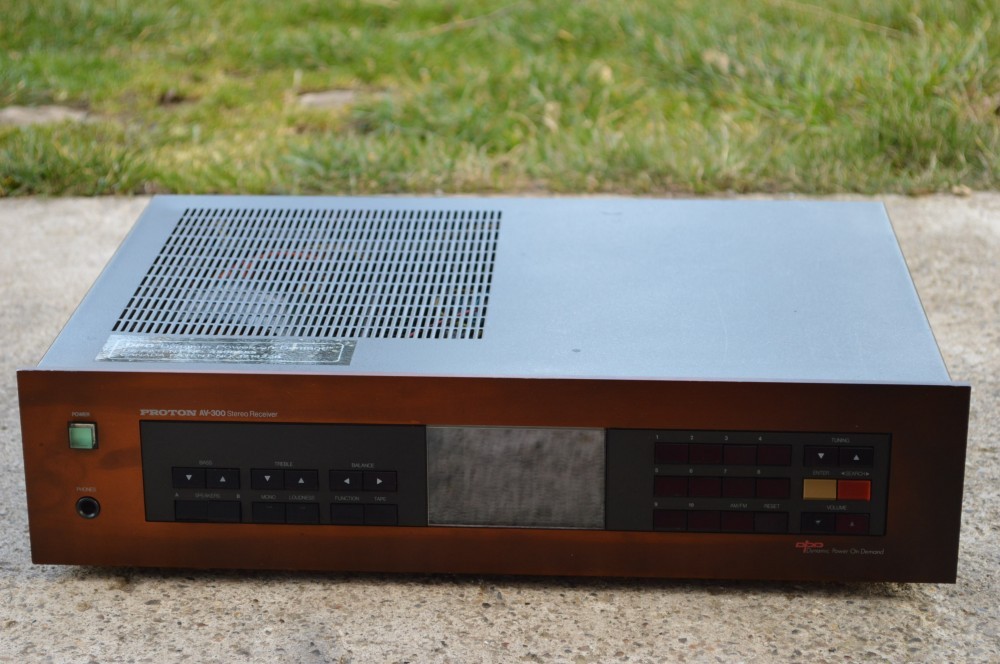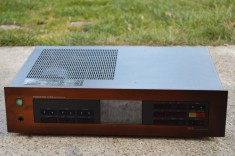Amplificator Proton AV 300
-
Produs:Second Hand, Certificat de garanție 3 luni
-
Numar articol:173285002
-
Disponibilitate:Indisponibil
-
Preț:
500,00 Lei300,00 Lei -
Anuntul a expirat la:11.01.2018, 14:22
-
Ai o nelamurire?
-
Vandut de:
-
Vinde si tu:Pune in vanzare un produs ca acesta
-
Optiuni:
Descriere
Vânzatorul este direct răspunzator pentru produsul afișat în această pagină.
Disponibilitate: Indisponibil - Vezi produse similare
Specificatii
Amplificator Proton: 4 intrari, 4 iesiri, reglaje bass, treble, balance, digitale, prezinta mici zgarieturi. Made in Taiwan. Suna foarte bine, sunet de audiofil. Radio nu functioneaza corespunzator.
THE BARGAIN HUNT goes on. Rising prices of sound equipment make thrift a necessity as well as a virtue for growing numbers of listeners. Following our initial foray into budget speakers last week, the spotlight now shifts to receivers in the same bracket.
Every true bargain in audio springs from a certain engineering attitude - a willingness to admit compromise for the sake of cost, combined with the ability to hide the compromise. In other words, a bit of inspired, and altogether legitimate, fudging.
As Abraham Lincoln pointed out, you can get away with clever tricks only some of the time - and so it is with fudged stereo receivers. In the long run, their limitations show. But for brief, crucial moments in music - for the duration of a cymbal crash, for example - cleverly concocted receivers or amplifiers can, as it were, impersonate a more powerful model.
What good is it, you may ask, that these designs can surpass themselves if their moment of glory is so brief? Luckily, in most kinds of music, the demand for high output power is concentrated into just such brief spans -mere fractions of a second. The extra power is needed during the instant the piano hammers hit the strings or the stick crashes against the drumhead. At such moments, receivers or amplifiers with insufficient power reserves falter and veer into distortion. It all happens so fast that listeners may not become aware of it each time it occurs. But the cumulative effect creates a blurry overlay that makes the music seem veiled.
To avoid this, serious audiophiles insist on high-powered equipment despite its considerable cost. Lately, however, a new design approach has achieved a workable compromise between price and power - and therein lies the bargain.
Receivers designed on this principle have rather modest power ratings, yet they possess the ability to exceed this nominal rating momentarily - just long enough to ride out those demanding musical peaks. In this way, the cumulative effect of what is called transient distortion is avoided, and the music remains sonically pristine.
This works for most kinds of music, but not for all; for there are passages requiring continuous power, not just brief bursts. A sustained organ note is a case in point, and so is a great orchestral chord held for several bars. Only ample (and expensive) wattage can deal with such sonic contingencies. But where cost must be weighed and the listener isn't enamored of music in the massive mode, low-powered receivers with ample momentary reserves - or headroom, as it is sometimes called - offer an acceptable compromise. In most types of music, the limitation in power will be masked by the headroom.
An outstanding design of this type is NAD's Model 7720PE receiver, which belies both its $298 list price and its nominal power rating of 20 watts per channel by filling even large rooms with full-throated sound. It rarely betrays audible signs of distress even at generous volume levels. Of course, to reduce any potential strain, it helps to use this receiver with efficient loudspeakers, i.e., speakers producing fairly high volume per watt. An efficiency rating of about 90 decibels per watt seems advisable.
The NAD 7720PE is also very well thought out in other respects. With a dynamic range of 100 decibels in its input stage, it can accept the most demanding signals from any CD with a good margin to spare. It also has an FM tuner with notably quiet background as well as a connection to accommodate the sound from a video recorder.
Other budget receivers with exceptionally good overload characteristics include the Rotel RX850 ($329) and the Denon DRA-25 ($280), both with nominal power ratings of 30 watts per channel.
The principle of extended headroom has been carried to its practical limit by Proton in that company's proprietary DPD circuit. The acronym stands for Dynamic Power on Demand and enables the output circuit to deliver up to four times its rated power. For exmple, Proton's AV-300 receiver, priced at $399, has a nominal output of 30 watts per channel. Yet thanks to DPD, it puts out a prodigious 120 watts at musical peaks.
Proton's engineers point out that it is not merely wattage that counts but the duration of the peak. In the case of DPD, the peak can be sustained for as long as half a second - quite a long time for things to happen in a musical score. Drumbeats will have long subsided before the power fades, and even a pianist's vigorous sforzando will not faze this receiver.
Bargain hunters may find other equipment at lower prices. However, in terms of musical capabilities and cost/performance ratio, it is doubtful that the models mentioned here can be surpassed in their class.
Vizualizati si celelalte licitatii, avem de departe cea mai larga gama de produse audio de inalta fidelitate, la cele mai bune preturi, in cele mai bune conditii. Boxe, amplificatoare, receivere, sisteme, cd playere, tunere, deckuri. Nu sunt interesat de schimburi. Ofer garantie.
Modalitati de livrare si plata
LIVRARE
In Cluj-Napoca
-
- Predare personala in max. 1 zi lucratoare
PLATA
- - La predare
- - Ramburs
Politica de retur
- - Produsul nu se poate returna.
Spune-ti parerea acordand o nota produsului




